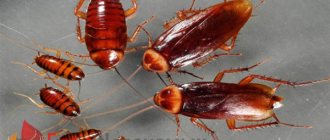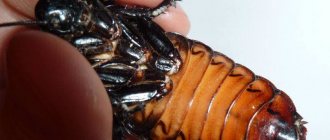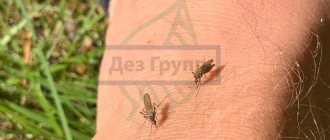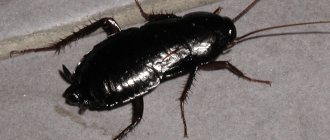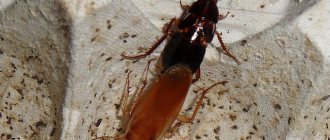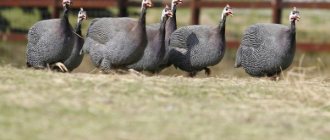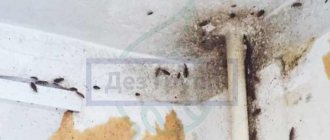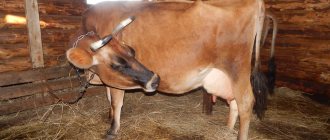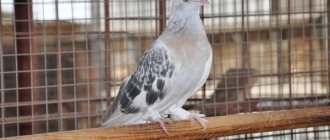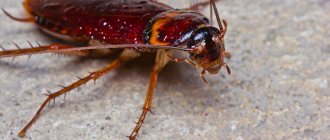- Wild animals
- >>
- Insects
The Madagascar cockroach is one of the many fascinating animal species native to the island of Madagascar. This insect looks and sounds different than anything else. This is a fascinating insect because of its unusual ability to produce sound. However, his unusual appearance and thoughtful behavior also contribute to his attractiveness.
Origin of the species and description
Photo: Madagascar cockroach
Madagascar cockroaches are an endemic species found only on the island of Madagascar. Close relatives of hissing cockroaches in Madagascar include mantids, grasshoppers, stick insects and termites.
Fun fact: Madagascar cockroaches are known as "living fossils" because these insects are very similar to prehistoric cockroaches that lived on Earth long before dinosaurs.
Madagascar cockroaches are docile, easy to care for, and are often kept as pets. They require a small room with a place where they can hide because they prefer to stay away from light. Due to their tendency to climb, the living area should be checked to see if they can climb out of the enclosure.
Video: Madagascar cockroach
Aquariums or terrariums found in pet stores work well, but it is wise to cover the top few inches of glass with Vaseline in order to prevent them from leaving their habitat. They can live on fresh vegetables along with any type of high protein pellet, such as dry dog food. Water can be provided by keeping a damp sponge in its natural environment.
Fun fact: In some places, people eat hissing cockroaches because they are rich in protein and easily available. Eating insects is called entomophagy.
Home maintenance
The reproduction and habitat of Madagascar cockroaches can occur at home. Breeding insects is very simple, even in the Russian Federation. The insectarium serves as the habitat of the house. Cockroaches do not smell, they are easy to keep and feed, and they take up little space. There is no need to walk an exotic insect either. In some cases, cockroaches are bred as food for lizards or tarantulas.
Reproduction and habitat of Madagascar cockroaches can occur at home
The terrarium must be equipped with:
- stone;
- snag;
- Each cockroach should have 1 liter of container volume.
For a couple of insects, you can take a small two-liter container. And for a family of 30, you will need a real aquarium of 30 liters.
Appearance and features
Photo: What a Madagascar cockroach looks like
The Madagascar cockroach (Gromphadorhina portentosa), also known as the hissing cockroach, grows up to 7.5 cm in length when mature. These cockroaches are one of the largest species of cockroaches. They are brown, wingless and have long antennae. Males have large bulges in the chest and antennae that are moister than those of females.
Unlike most other cockroaches, they do not have wings. They are excellent climbers and can climb smooth glass. Males are distinguished from females by thicker, hairier antennae and pronounced “horns” on the pronotum. Females carry a carton with eggs inside and release young larvae only after the eggs hatch.
Like some other forest-dwelling cockroaches, parents and offspring usually remain in physical contact for long periods of time. In captivity, these insects can live 5 years. They feed mainly on plant material.
While many insects use sound, the Madagascar hissing cockroach has a unique way of creating a hiss. In this insect, sound is created through the forced displacement of air through a pair of modified abdominal spiracles.
Spiracles are breathing pores that are part of the respiratory system of insects. Because the airways are involved in respiration, this method of sound production is typical of the respiratory sound produced by vertebrates. In contrast, most other insects produce sound by rubbing body parts (such as crickets) or vibrating a membrane (such as cicadas).
Reviews and comments
+1 Dmitry 02/21/2017 11:27 I got myself a dozen of these cockroaches, I keep them at work as a joke, my colleagues are used to them. I got them small, 5 mm each, now they have grown to 3 cm. I built them for them from a plastic tray, bamboo sticks and matchboxes this is the design.
got them small, 5 mm each, now they have grown to 3 cm. I built them for them from a plastic tray, bamboo sticks and matchboxes this is the design.
I feed him what I eat for lunch. Thanks for the article, I found a lot of interesting things for myself. The only thing: you write “The Madagascar cockroach is a hissing pest” and at the same time “at the same time, there is no harm from the barbels. They do not pose a threat to humans." So is he a pest or not? Quote
Where does the Madagascar cockroach live?
Photo: Madagascar hissing cockroach
These large pests thrive in warm climates and become sluggish in cold temperatures. Little is known about its ecology, but the insect probably lives on the forest floor in rotten logs and feeds on fallen fruit.
Madagascar hissing cockroaches live in damp places including:
- places under rotten logs;
- forest habitats;
- tropical areas.
Madagascar cockroaches are native to the island of Madagascar. Because they are not native to the country, these pests are rarely the cause of cockroach infestations in the home.
To keep these cockroaches at home, the following rules should be followed:
- the aquarium or other container should be large enough to allow the cockroaches room to move around. Clear plastic or glass are best so you can more readily observe their behavior;
- a lid is needed for the tank to prevent them from escaping. Although wingless, they are quite mobile and can climb up the sides of a container;
- mouse bedding or wood shavings will line the bottom of the cage. Bed linen should be changed periodically, especially if there is a high level of humidity;
- a wooden block or log is needed for them to crawl. Cockroaches tend to become aggressive if any object is present in the cage;
- there should be a tube filled with water and covered with cotton wool. Cockroaches will drink water from the cotton and push it back into the tube to keep it moist;
- The water must be changed every week.
Breeding cockroaches at home
Madagascar cockroach: breeding.
Madagascar cockroaches are mainly raised as food for lizards and snakes. But some exotic lovers breed hissing cockroaches as pets. They live and reproduce in a warm and humid container with an air temperature of +25-+28 degrees and humidity not higher than 70 percent.
The lid must have holes for ventilation. You can add sawdust or coconut shavings to the bottom. In order for cockroaches to hide during the daytime, you need to equip shelters. You can buy them at the store or make them yourself from what you have at home. Place a drinking bowl at the bottom and put pieces of cotton wool in it to prevent the cockroaches from drowning.
Several rules require special adherence:
- The container must be closed. Although they cannot fly, they actively crawl.
- A transparent lid and walls are perfect - it's fun to watch the animals.
- Cockroaches do not like anything unnecessary, foreign objects can irritate them, and they show aggression.
- Bark or driftwood is required to shelter the animal.
- Make sure there is always water and enough food in the drinking bowl.
- Change the litter once a month.
- Maintain the temperature in the container, otherwise the cockroaches will grow and develop poorly.
What does the Madagascar cockroach eat?
Photo: Female Madagascar cockroach
In their natural environment, Madagascar hissing cockroaches are useful consumers of carrion and rot.
Hissing cockroaches are omnivores that feed mainly on:
- animal carcasses;
- fallen fruit;
- rotting plants;
- small insects.
Interesting fact: Like 99% of all cockroach species, Madagascar cockroaches are not pests and do not inhabit human homes.
These insects live on forest floors, where they hide among fallen leaves, logs and other detritus. At night they become more active and scavenge for food, feeding primarily on fruit or plant materials.
At home, Madagascar cockroaches should be fed a variety of fresh vegetables and fruits, as well as green leaves (except iceberg lettuce) in combination with a high protein kibble food such as dry dog food.
Carrots seem to be a favorite, along with oranges, apples, bananas, tomatoes, celery, pumpkin, peas, pea pods and other colorful vegetables. Remove any leftover food after some time to avoid spoilage. The water should be served in a shallow container lined with cotton or other material that can absorb the liquid to prevent your cockroaches from drowning.
Madagascar cockroaches are hardy, like most cockroaches, and have few health problems. It is only important to monitor hydration. If your pet cockroach looks shriveled or wrinkly, it is likely not getting enough water.
Now you know what to feed the Madagascar cockroach. Let's see how it survives in the wild.
Behavior
Like all cockroaches, our hissing friends don't like it when anyone looks at them, and they also don't react very positively to light. Madagascars are quite slow compared to their counterparts, so when handled they will rather press themselves against the surface they are on, making them very difficult to lift due to their smooth shell. But the most important feature of cockroaches, living up to their name, is the ability to hiss. The hissing is created when the cockroach exhales air through special spiracles between the shields of the shell, and such a defense mechanism can frighten almost anyone who has not encountered such a phenomenon before. Previously, it was believed that only males could hiss, but females also have this ability, but they hiss only in extreme cases, or when there are no relatives nearby. In the colony, Madagascars establish a strict hierarchy. More dominant cockroaches often fight with others over females. A sign of defeat is the weaker cockroach turning over onto its back. Life expectancy in captivity is on average about three years. Rarely live to be five and even more rarely six years old.
Features of character and lifestyle
Photo: Male Madagascar cockroach
Males use the horns in aggressive confrontations reminiscent of battles between horned or antlered mammals. The rivals hit each other with their horns (or abdominal cavity) and often make amazing hisses during the fight.
Madagascar cockroaches make the hissing sound for which they are famous.
Four types of hissing have been identified, with different social purposes and amplitude patterns:
- the hiss of a male fighter;
- courtship hiss;
- mating hiss;
- alarm hiss (a loud hiss that frightens predators).
The cockroach hisses by pushing air through a pair of modified spiracles, which are small holes through which air enters the insect's respiratory system. The spiracles are located on the sides of the chest and abdomen. They are believed to be one of the only insects that use their spiracles to make sound. Most other insects produce sound by rubbing parts of their bodies together or by vibrating their diaphragms.
Male Madagascar cockroaches hiss more as they establish territories and defend themselves from other males. The size of their territory is small. The male can sit on a rock for months and defend it from other males, leaving it only to find food and water.
Aggressive hissing and posturing are used to warn other males and predators - the larger male who hisses more often wins. A dominant male will stand on his “toes,” called stilts. Stilting is a way for males to “show off.” Males use humps on their pronotum as a defense mechanism. The pronotum is a plate-like structure that covers most of their thorax. Fighting between males does not cause injury.
Females are more sociable and do not fight with each other or males. Because of this, they are less prone to hissing, although in rare cases the entire colony may begin to hiss in unison. The reason for this behavior is not yet understood. Females carry the egg inside and release young larvae only after the eggs hatch. As with some other wood-dwelling cockroaches, parents and offspring typically remain in close physical contact for long periods of time.
Hissing sound
Hissing cockroaches have a pair of modified spiracles; These are tubes that insects use to breathe. These insects use these spiracles to produce the hissing sound that inspired their name. They hiss when disturbed, and males also hiss when courting females. Sometimes an entire colony hisses in unison, for reasons that are not yet clear to researchers.
The sibilants force the air through their spiracles to produce all their various hissing sounds; one call is used to attract a mate, another is used when the cockroach feels threatened (known as an "alarm" hiss), and the third known hiss is a warning, used when a male cockroach is preparing to attack another male.
Adult male cockroaches can be identified by two large, prominent tubercles (tubercles) on the dorsal plate (prothorax) behind the head. Adult females also have tubercles in the same location, but they are smooth.
Social structure and reproduction
Photo: Baby Madagascar cockroaches
The Madagascar cockroach even begins its life in an unusual way. The life cycle of the hissing Madagascar cockroach is long and different from most other cockroaches. Females are oviparous, with the female carrying the eggs and raising the newborn larvae inside her body for approximately 60 days until they become first-order larvae.
One female can produce up to 30-60 larvae. This insect has an incomplete life cycle: egg, larva and adult stage. The larvae undergo 6 moults before reaching maturity after 7 months. Larvae and wingless adults can live from 2 to 5 years.
There are striking differences between the sexes. Males have large horns behind their heads, while females have small “bumps.” The presence of anterior horns makes it easy to recognize the sex. Males have hairy antennae, while females have smoother ones. The behavior of men and women also differs: only men are aggressive.
Madagascar cockroaches molt (shed their outer skin) six times before they reach maturity. This is the period when the cockroach is most vulnerable. He may not eat for a whole day before molting as he prepares his body for the process. When it reaches 7 months, it stops molting and reaches maturity.
Eating exotic insects
There is a delicacy in Thai cuisine - fried Madagascar cockroaches. The meat resembles ham. It contains a lot of protein and is completely free of fat. Healthy dietary dish. Preparation of the delicacy begins with the removal of the cephalothorax and wings. The remaining part is placed in a hot frying pan with the addition of vegetable oil. If you feel sorry for eating pets, but want to try the delicacy, you can peel and fry king prawns. The taste and appearance are identical. You can eat Madagascar cockroaches with fresh vegetables.
Natural enemies of Madagascar cockroaches
Photo: What Madagascar cockroaches look like
Madagascar cockroaches likely have many species of predators, but there are few documented relationships between them. Arachnids, ants, tenrecs and some land birds are likely predators of these cockroaches. As mentioned earlier, an anti-predator strategy is an alarm hiss, which produces a loud snake-like noise that can startle potential enemies.
The mite Androlaelaps schaeferi, formerly named Gromphadorholaelaps schaeferi, is a typical parasite of the Madagascar cockroach. These mites form small clusters of four to six individuals at the base of the leg of their cockroach host. Although it was originally thought that this mite was a bleeder (blood-sucking), recent research has shown that the mite simply "shares" the cockroach's food items.
But since these mites do not harm the cockroaches they live on, they are commensals rather than parasites unless they reach abnormal levels and begin to starve their host. Recent studies have shown that these mites may also have beneficial properties for cockroaches as they clean the surfaces of cockroaches of pathogenic mold spores, which in turn increases the life expectancy of cockroaches.
The insects themselves pose no known danger to humans. Males are extremely aggressive and usually fight rival males. Male cockroaches create and defend territories using a unique sound. They are very territorial and use their horns in combat. Females only hiss when disturbed.
How do they reproduce?
The breeding process of Madagascar cockroaches has its own characteristics. After mating, a capsule with eggs is formed inside the female - an ootheca. The female does not shed it in a secluded place, like cockroaches of other species, but carries it until she begins to give birth. In this case, the larvae emerge from the abdomen and crawl onto the back of the female along with the remains of the ooteca. Small cockroaches remain under the supervision of an adult for a long time and only when they are strong enough do they crawl to the ground and begin to explore the world on their own.
At the same time, the female Madagascar cockroach is constantly close to her offspring. She calls them with a muffled hiss, and in case of danger makes sharp scaring sounds.
In the process of turning a larva into an adult, 5-6 molts occur, since the insect’s body grows, but the size of the shell does not change. The full cycle of transformation of a larva into a sexually mature individual takes 6-12 months.
Requirements for keeping in captivity
You need to know what to feed insects. The source of life is water, which cockroaches get from fruits. Breeding in captivity presupposes the need to provide a safe watering area where pets cannot drown. It is necessary to include fruits in your diet. In addition, the cockroach should receive cereals (buckwheat, oatmeal) and dry fish food. You need to give the insects leaves of cabbage, lettuce, dandelions, and also boiled eggs.
If you plan to keep Madagascar cockroaches, their maintenance requires a careful approach:
- The humidity level is within 65%, for which the insects’ home is periodically sprayed with water and containers with liquid are installed;
- The air temperature should not go beyond +18...+30 degrees;
- Ventilation holes are made in the aquarium with a lid.
The main thing is that food is constantly in their cage and is varied, otherwise insects may exhibit cannibalism
Black cockroach (Blatta orientalis L)
A type of pest that lives in our region, the black cockroach is found in apartments much less frequently than the Prussian cockroach; in the summer they live in basements, landfills and abandoned places. The black cockroach reproduces more slowly, so red pests have practically squeezed this species out of apartments and houses, and besides, red cockroaches eat the larvae laid by female black cockroaches. This species is popularly called the oriental cockroach.
They feed on any food that comes under their paws; the chitinous shell has a dark color from black to dark brown. Black cockroaches secrete an enzyme that creates an unpleasant odor in the room.
The black cockroach is a distributor of many diseases; thanks to its lifestyle, which consists of searching for food in sewers, landfills and basements, they are much more likely to carry infection than red cockroaches. If you notice black cockroaches in your kitchen, you should immediately purchase cockroach repellent.
Furniture cockroach
Furniture cockroaches were discovered in Russia about 100 years ago. From the name it is clear that these insects like to hide in furniture. These cockroaches can often be found in city libraries, furniture workshops and bedrooms.
A characteristic feature of these cockroaches is their light color, as can be seen in the photo below.
American cockroach
Its homeland is Africa, but it was brought to America and it has taken root remarkably well in human homes, where the optimum air temperature is constantly maintained and food is abundant.
The size of the insect does not exceed 3 cm and the reproduction rate is inferior to the Prussians familiar to us. The American cockroach was able to move to Europe and even took root in many countries with a relatively warm climate.
Vietnamese cockroach (Shelfordella tartara)
This species lives in the southern regions of Russia and is known under the names “Turkestan cockroach” and “Central Asian cockroach”. This cockroach is quite rare and lives mainly on the street. Adults reach 2.5 cm and are able to jump far, assisted by their wings. The cockroach has a dark abdomen and a yellow cephalothorax, which is clearly visible in the photo.
